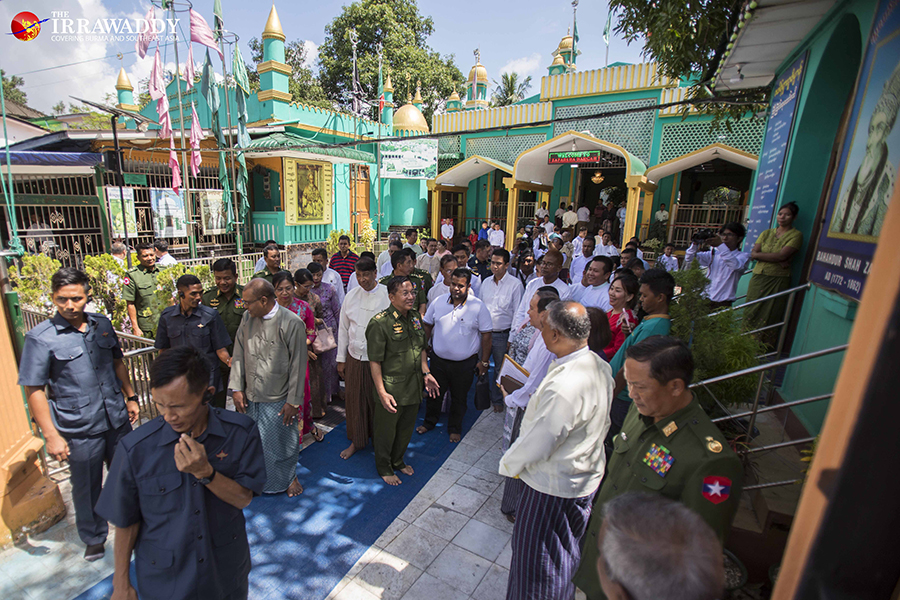Have you ever entertained the notion that Myanmar’s military chief, Senior General Min Aung Hlaing, could be the president of the country after the 2020 election? No one should underestimate him, as politics here are more unpredictable than anywhere. Still, the possibility depends on at least one big “IF”.
The commander-in-chief could be the president, IF—as I said—the Union Solidarity and Development Party (USDP), formed by the ex-military regime and still the key ally of the military, and its allied parties win 26 percent of the seats in the bicameral Union Parliament.
Hold on. Before we talk about that, first we have to think about whether or not he wants to be the president.
Many critics and observers believe that the senior general is aiming for the post. In the past, when asked by media in exclusive interviews whether he seeks the top office, the military chief has never said “no”.
The commander-in-chief, now 63, may well see himself as the president after the 2020 elections. He was supposed to retire in July 2016 when he turned 60 (the retirement age for civil servants). The National League for Democracy (NLD) government seemed to have expected him to voluntarily retire, but instead the military chief extended his term.
The Union president needs to approve any extension in the commander-in-chief’s term. At the time of Sen-Gen Min Aung Hlaing’s extension, there were reports that the then-president, the NLD’s U Htin Kyaw, initially refused to approve it, leading to tension between the commander-in-chief and the NLD government.
The military chief’s actions in recent weeks have raised a lot of eyebrows. He has made many visits and donations to Christian and Muslim religious groups in some big cities, including Mandalay and Yangon.
The recent moves are unprecedented in Sen-Gen Min Aung Hlaing’s tenure as commander-in-chief, which began in 2011. Many observers see his move as little more than public relations to counter allegations and condemnations of religious persecution that have been leveled at him, and as a form of public political campaigning.
Some in the international community have been pressing for the military chief to face trial at the International Criminal Court (ICC) over the military’s disproportionate clearance operations against Rohingya Muslims after Rohingya insurgents ambushed police outposts in Rakhine State in 2017.
Caught between domestic and international pressures, Snr-Gen Min Aung Hlaing would be happy to see himself as the president. Such a scenario would be a kind of “revenge” against all his adversaries, inside and outside the country. Or, he may be motivated by simple egoistic ambition.
To the military, the USDP and even his ex-boss, Senior General Than Shwe, Sen-Gen Min Aung Hlaing would be a hero if he took back the throne after five years of NLD rule—not through their old traditional method of a coup, but via the constitutionally mandated electoral process.
Given this calculation, it seems highly likely that he would want to be the president.
The next question concerns how he might achieve that, and what his chances are.
That depends on the big “IF” factor mentioned above. He could be the president if the USDP and its allied parties get 26 percent of seats in Parliament.
That seems unlikely, as the USDP now holds only 6 percent of all seats in Parliament, while the ruling NLD, led by the country’s de facto leader Daw Aung San Suu Kyi, holds over 59 percent, with 25 percent held by the military’s representatives. The other parties, mostly ethnic ones, hold over 9 percent.
But when the election is held next year, the political landscape will be considerably different than it was at the time of the last vote in 2015. Even today, given the fact that many ethnic people and parties feel quite upset with the NLD and alienated by its policies, the NLD would struggle to repeat the huge electoral landslide it achieved in 2015.
Under these circumstances, the USDP might expect more votes, and more parliamentary seats. But the ethnic parties are likely to be the winners in some of their ethnic areas. Among those ethnic parties, we have to wait and see how many of the USDP’s allies will win, and how many of them would be willing to join with the USDP to form the government.
With the decline of the NLD’s popularity in the ethnic areas, we can’t rule out the possibility that the USDP and its allied parties—there are about 25 of them—will get 26 percent of the parliamentary seats.
So, “IF” the USDP and its allies were to win 26 percent of the seats, you might expect that with the military holding 25 percent of seats as guaranteed by the Constitution, USDP chairman U Than Htay would become president, given that his party would hold more seats than the military.
But no, that is not going to happen. The real winner would be Snr-Gen Min Aung Hlaing.

Before we spell out our theory of how he could become president, you need to understand that under the Constitution, the president and vice presidents aren’t elected in general elections. Anyone could be president, provided the Union Parliament elects them.
Thus, Snr-Gen Min Aung Hlaing doesn’t need to contest the election to become president. The Constitution the ex-military regime drafted can make him vice president quite easily.
In Myanmar’s presidential electoral process, three groups in Parliament elect their respective vice presidents: 1) elected members of the Lower House (Pyithu Hluttaw); 2) elected members of the Upper House (Amyotha Hluttaw); and 3) the military’s (unelected) representatives.
The military representatives select their vice president based on the instructions of the commander-in-chief. The current first vice president is ex-general U Myint Swe, who was selected by the military representatives via the presidential electoral process after the 2015 elections.
After the 2020 elections, therefore, Snr-Gen Min Aung Hlaing could instruct his appointed military representatives in Parliament to select him as vice president. Like it or not, no one – meaning no one in the government or other parties – could prevent this, as it would be in line with the Constitution.
So, let’s imagine he is now a vice president. How can he become the president?
We need to think about who the two other vice presidents would be. Remember—according to the assumption we’ve outlined above, the USDP and its allied parties hold 26 percent of the seats in Parliament. But we can be pretty sure the NLD—even if it doesn’t repeat its 2015 landslide of more than 50 percent of all seats in Parliament—will have gotten far more votes than the USDP.
The point is that the NLD candidates in each chamber will outnumber the USDP and its allied parties. In that scenario, the NLD can still elect its own party members to the two other vice presidential posts.
So, we now have three vice presidents – one from the military and two from the NLD. Thus, there would be no chance of any USDP candidate becoming vice president, even with it holding 26 percent of seats in Parliament.
Now, the remainder of the process involves electing a president from among the three vice presidents.
Back in the bicameral Parliament, the combined seats of the military, the USDP and its allied parties outnumber the NLD’s seats. Members of the two houses of Parliament, including the military appointees, must elect the president. Obviously, the NLD’s two vice presidents stand no chance.
In this scenario, the USDP and its allied parties have no choice but to join with the military representatives to select their vice president—Snr-Gen Min Aung Hlaing.
So, under our scenario, the president for the term of 2021-2026 is to be Snr-Gen Min Aung Hlaing.
But it’s not a complete theory yet. What if there is no big IF for Snr-Gen Min Aung Hlaing?
Many local and foreign observers believe he doesn’t want to be a vice president if he can’t be the president.
But why shouldn’t he? I don’t think he has anything to lose being a vice president—and he has much to gain. So, he could surely be a vice president even if he can’t be the president. The vice president position would still be a platform allowing him to show that he was able to reach one of the most senior government positions even as the international community sought to send him to the ICC. And it could also be a form of protection for him. All he needs to do before deciding to join the government as the president or vice president is to choose a loyal general from among his deputy generals to succeed him as the military chief.
Perhaps now it is a little easier for you to imagine Snr-Gen Min Aung Hlaing serving as the president in March 2021 and beyond.
Obviously, he would not be a president chosen by a majority of Myanmar’s people or their elected representatives. Which means any government he formed would not be by the people, and, as a result, would not be for the people. And the direct consequence for the NLD would be a loss of power, despite having received a majority of the ballots cast in the election.
You can imagine what the country would look like under Snr-Gen Min Aung Hlaing’s presidency; how much the country’s current political course would change and the impact it would have on Myanmar’s relationship with the international community.
This is not a prediction; rather, it is one theoretical scenario that could play out in Myanmar’s politics. Anyway, it could be a true story of survival—the story of a Myanmar general who was able to escape the threat of prosecution in The Hague, and international condemnation, to defeat the popular and elected NLD. He might end his political career as the president: it’s a big IF, but there’s also the possibility of vice president.
You may also like these stories:
Mosques Reopen in Myanmar’s Magwe 10 Years After Bloody Riots
USDP Leader Urges Myanmar Citizens to ‘Take Care of the Race’
Myanmar Military Chief Meets Kachin Religious Leader
Myanmar Military Chief Asks Thai PM to Help 2 Migrant Workers on Death Row

















